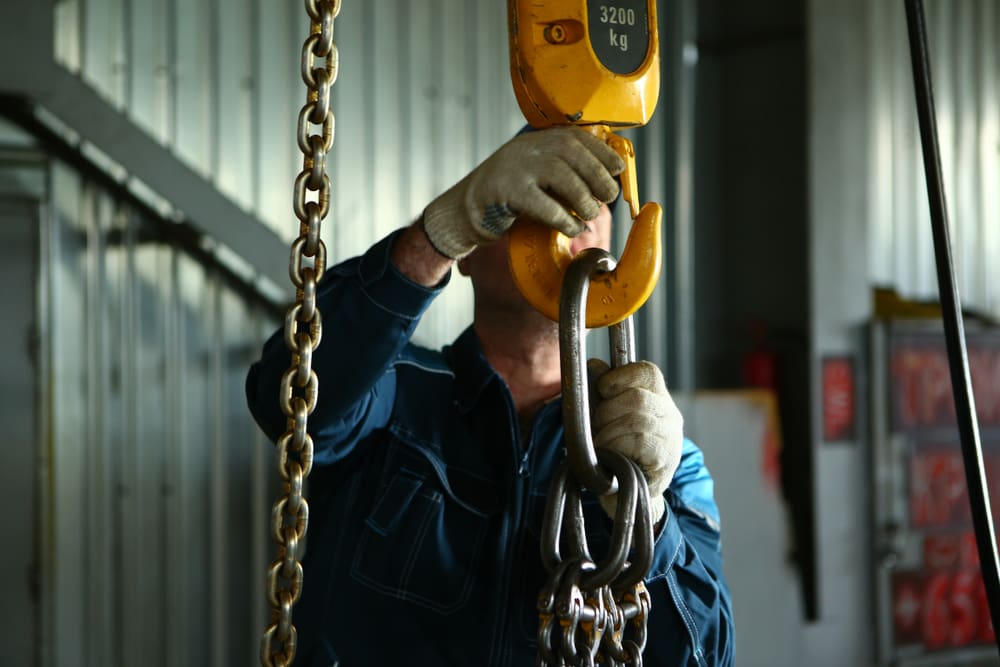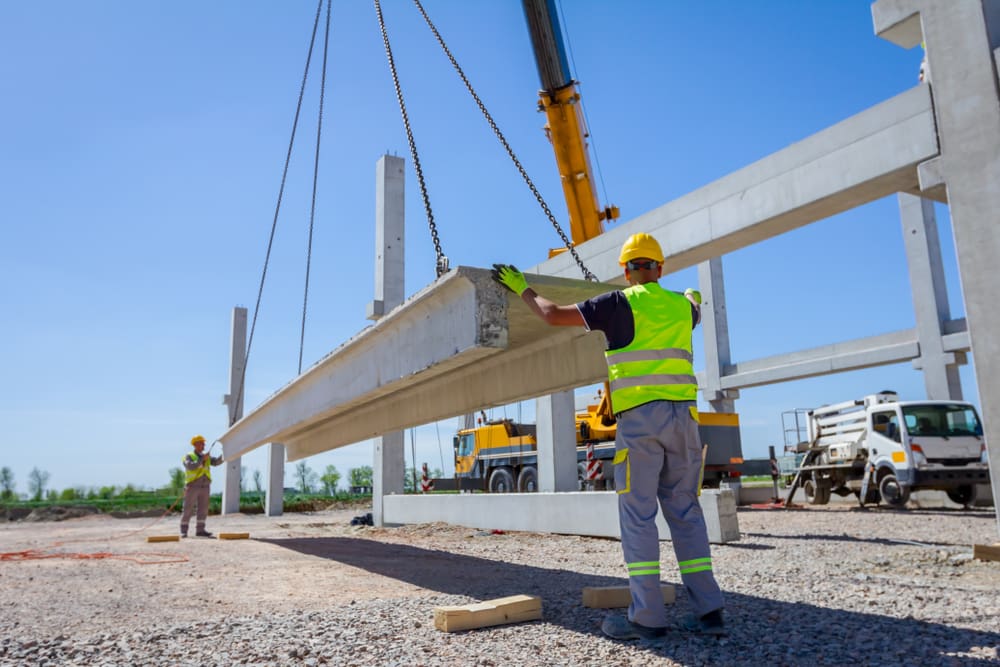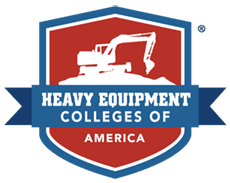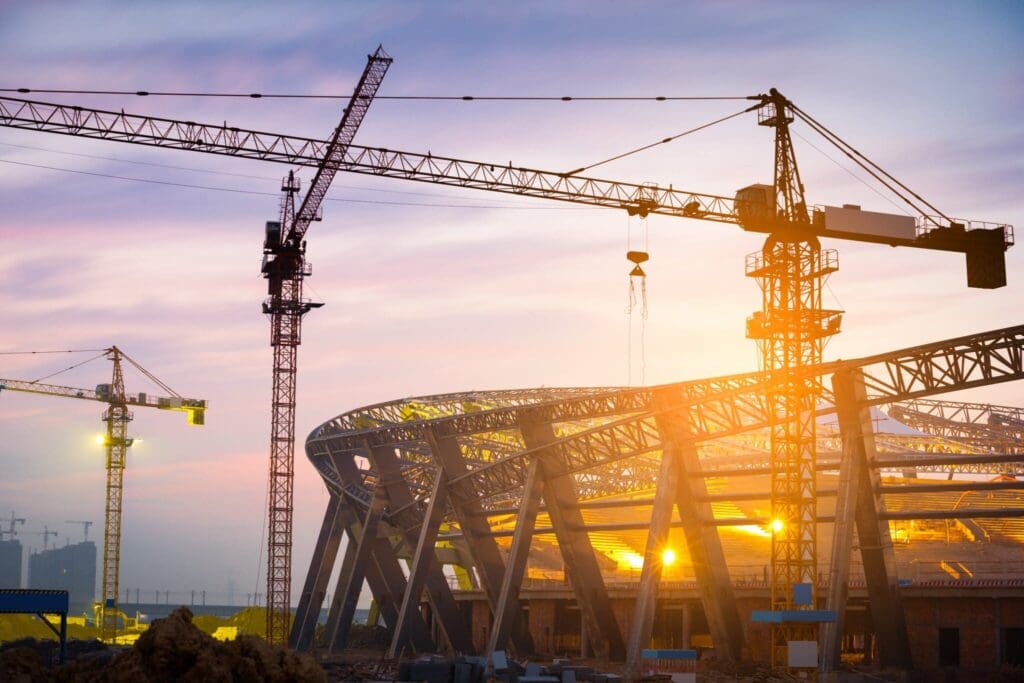We’ve all driven past a construction site and seen a crane the size of a skyscraper. It’s an impressive sight, but how does something so massive get there? There must be a process to ensure the tower crane is securely set up and stable—especially when it’s tasked with lifting heavy construction materials. These high-rise tower cranes can reach incredible heights, and assembling one is a complex process requiring precision and expertise.
If you’re interested in how tower cranes are erected, Heavy Equipment Colleges of America (HEC) has the answers. We’ll cover the basics of what a tower crane is, as well as how they are safely assembled to reach such impressive heights for construction sites.
Table of Contents
What Are Tower Cranes?
Tower cranes allow us to build high-rise buildings and skyscrapers without having to grow wings. They consist of a concrete foundation and a steel arm that allows workers to lift and transfer materials across a job site.
Not just anyone can steer one of these. It requires a specific tower crane operator training program to become a certified operator.
The Role of Tower Cranes in Construction
Tower cranes transport construction materials to impressive heights to help us build bridges and other large structures. They can help get materials where they need to be, clear construction sites, and support other construction jobs such as equipment assembly.
The 3 Types of Tower Cranes
Tower cranes come in a variety of sizes and designs for different loads and job sites. Picking the right one for the job can keep workers safe and maximize job site efficiency. The three types of tower cranes include:
- Hammerhead Tower Cranes: These get their name from the horizontal jib and counter-jib that create a hammerhead shape. This gives the crane more balance and allows it to carry large loads with ease.
- Luffing Jib Tower Cranes: Luffing jib cranes have a jib that can be angled or “luffed” to different positions, allowing it to maneuver in tight spaces—ideal for high-rise construction projects with overhead obstructions.
- Self-Erecting Tower Cranes: These cranes have a hydraulic system that allows them to raise and lower sections automatically without the need for additional equipment. This makes them a great option for job sites with limited space.

Parts of a Tower Crane
- The Concrete Pad (or Base): The base supports the crane and keeps it in place. It can be either a slab of concrete or a steel platform, allowing the tower crane to stand strong in a fixed position. Concrete slabs can span a 30-foot by 30-foot range and weigh about 400,000 pounds.
- The Mast (or Tower): The mast refers to the tall, vertical portion of the tower crane. Sections can be added or removed to reach the desired height of the crane. It also needs to be strong enough to support the weight of the crane itself and the load it’s carrying. Masts can reach around 265 feet or higher and are typically made of steel trusses.
- The Slewing Unit: This unit sits on top of the mast, just below the operator’s cabin, and allows the crane to rotate horizontally.
- The Boom (or Jib): The boom or jib is the long arm of the crane that extends horizontally away from the slewing unit.
- The Machinery Arm: Also known as the counter jib, this smaller arm extends in the opposite direction from the main jib and offers a counterbalance to keep the crane stable.
- The Trolley: This is a motorized component that moves along the boom to move the load back and forth. It uses a series of pulleys to move the load across the jib to where it needs to go.
- The Hoist: The hoist is the massive cable you see dangling from a tower crane, and it’s what moves the load up and down. It uses a series of pulleys to raise or lower the load.
- The Hook: This is what attaches the load to the hoist, and it can look different depending on the type of load the crane is carrying.
- The Operator’s Cabin: As the name suggests, this is where the crane operator sits and controls the crane’s movements.
- The Control System: This system manages how the tower crane moves, handles loads, and engages safety features. This system is both electronic and hydraulic.
- The Counterweight: The counterweight sits behind the operator’s cabin, and it helps keep the tower crane balanced as it swivels with a load.
- The Climbing System: This hydraulic system allows the tower crane to carefully raise itself to help with crane assembly and dismantling.
Understanding Crane Lifting Capacity
Key Points About Tower Crane Assembly
When learning how to raise a tower crane, there are a handful of important factors to keep in mind throughout the process that will keep you safe and improve efficiency on the job site.
- Mobile Crane Assistance: With their massive height, you need a mobile crane to help you put together a tower crane. A mobile crane can lift larger tower crane parts and make the assembly safer and faster.
- Climbing Frame: The climbing frame attaches to the top of the tower crane and lifts it so new mast pieces can be attached underneath it. This is what allows these cranes to get as tall as skyscrapers.
- Balancing The Load: While assembling a tower crane, it’s vital to make sure the loads are properly balanced. An unbalanced load can make the crane unstable, making assembly more dangerous and increasing the risk of a collapse.
- Concrete Foundation: Tower cranes require a solid concrete foundation to support the crane’s weight and keep it balanced.

How Are Tower Cranes Put Together for Construction Sites?
1. Base Installation: The first step is to lay the foundation. This can either be a concrete or steel slab that the mast is anchored to and built on. The base supports the entire tower crane during construction, so it needs to be sturdy.
2. Initial Mast Sections: A mobile crane will erect the mast to a predetermined height, and then from there attach other components. The mast segments are hoisted up by the mobile crane and then snapped together like puzzle pieces.
3. Slewing Unit and Jib Attachment: The next step is to attach the slewing unit, the jib, and other attachments. The slewing system goes on the topmost part of the tower crane, and the jib is connected to the slewing system.
4. Counterweight Installation: The counterweight is installed behind the main cabin, and this keeps the crane balanced as it moves around. The machinery arm also goes on at this time on the opposite side of the main jib to provide additional counterweight.
5. Climbing Process: Once the key components are attached, the climbing process begins. The top of the crane will be hoisted up with the hydraulic climbing system, and another mast section will be added, allowing the crane to get taller. Each mast section is carefully added one at a time to ensure the tower crane stays balanced.
6. Repeat Climbing Process: The climbing process is then repeated until the crane is at the designated height for the job. More mast pieces are stacked together until the crane reaches the proper height, yet the climbing system stays connected to the crane until the job is done. The hydraulic system also helps take the crane apart once it’s no longer needed, so it stays put.

How Much Weight Can They Lift?
You don’t know power until you’ve seen a tower crane in action. A tower crane’s lifting capacity could reach up to 18 metric tons. However, it cannot handle that much weight if the load is positioned at the end of the jib.
When the load is positioned close to the mast, the crane can handle heavier weights safely.
Here is how you can find the capacity limit at a certain position. Using the 300-tonne-meter rating, you can calculate that a load at 30 meters (100 feet) from the mast means the crane can lift a maximum of 10.1 tons.
How To Read A Crane Load Chart?
Why Don’t They Fall Over?
Wondering how tower cranes can be so tall and so powerful without tipping or collapsing? Just like the building they’re constructing, a tower crane draws its stability from its foundation.
In this case, the foundation is a 400,000-pound concrete pad. The base of the crane is bolted down to the pad, keeping the tower stable throughout the operation.
How Long Does it Take to Erect a Tower Crane?
On average, it takes around 2 to 3 days to assemble a tower crane. The exact timeline depends on factors such as the size and complexity of the crane, the weather outside, and the availability of support equipment such as mobile cranes.
Safety Measures During Crane Erection
- Personal Protective Equipment (PPE): Hard hats, safety harnesses, high-visibility clothing, and steel-toed boots all protect you on the job site and help prevent serious injuries.
- Certifications and Training: To properly assemble a tower crane, all personnel involved need to be certified and trained to work with tower cranes or other related equipment.
- Inspections: Before assembling, all tower crane parts must be inspected for any damage or malfunctions that could compromise the structural integrity of the crane.
- Pre-Assembly Planning: Plan how, when, and where the tower crane will be assembled before you begin putting the pieces together.
- Emergency Preparedness: Everybody on the job site needs to know the proper protocols in the event of an emergency. It’s always better to plan for the worst than scramble if something happens.
Want to Become a Tower Crane Operator?
Thinking about becoming a tower crane operator? Then there are a few things you need to do first. First, you need training and certification from a crane operator training school. Tower cranes are powerful machines, but one mistake could spell disaster. You can learn all about the parts of a crane, safety procedures, and other important information in a heavy equipment operator training program.
Where Can You Find the Best Tower Crane School?
Deciding to go back to school or continue your education can seem like an uphill battle, but choosing the right program for you will make all the difference. The best programs will offer you accelerated paths to entering the job market with the right credentials and training. They’ll also assist you beyond the classroom through career services.
Ready to start your career as a tower crane operator? Heavy Equipment Colleges of America (HEC) has a tower crane program that you can complete in as little as two weeks. You’ll gain hands-on experience and learn from experienced instructors as you prepare for certification. Once you’ve completed the program, you’ll have access to career services like resume writing, mock interviews, and more.
HEC also has other heavy equipment training programs that you can complete in as little as three weeks. Explore your options at our multiple locations across the country.

